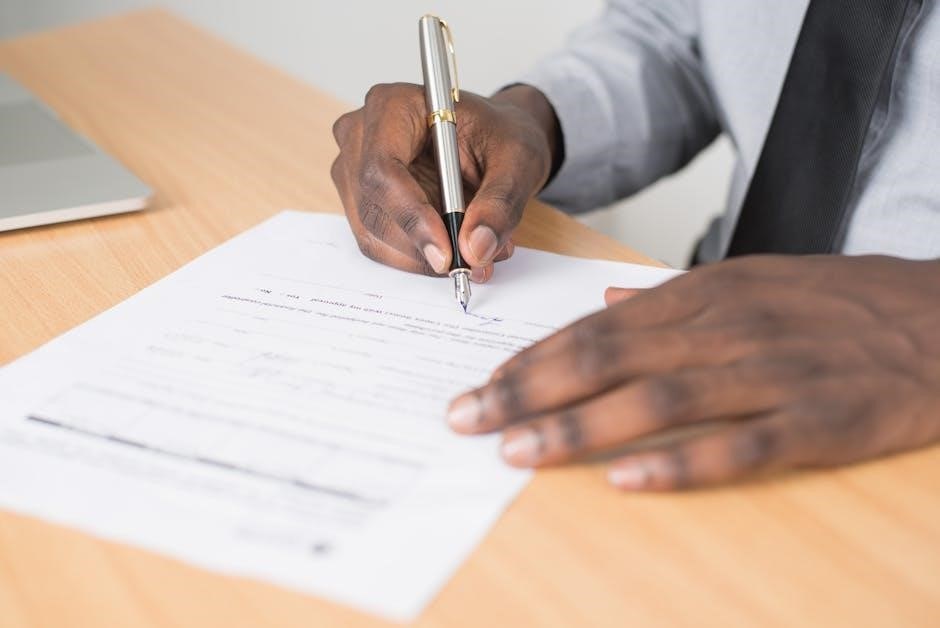A Hold Harmless Agreement is a legal contract protecting one party from liability for damages or losses incurred during specified activities. It ensures indemnification, defending against claims arising from such actions, and is commonly used in construction, events, and service contracts to allocate risk and provide legal protection to the indemnitee.
1.1 Definition and Purpose
A Hold Harmless Agreement is a legal contract that protects one party (the indemnitee) from liability for damages or losses incurred during specified activities. Its primary purpose is to allocate risk and provide legal protection by ensuring the indemnitee is not held responsible for unforeseen events. This agreement can be mutual or unilateral, depending on the situation, and is essential for clarifying responsibilities. It safeguards against claims arising from the actions of the indemnitor, ensuring a clear understanding of liability and indemnification obligations.
1.2 Importance in Legal and Business Contexts
A Hold Harmless Agreement is crucial for minimizing legal and financial risks in various business and contractual relationships. It protects parties from liability arising from unforeseen events, ensuring indemnification for damages or losses. This agreement is essential in industries like construction, events, and services, where risks are inherent. By allocating liability clearly, it prevents disputes and safeguards assets. It also demonstrates due diligence, fostering trust and stability in partnerships. Drafting such agreements with legal precision is vital to ensure enforceability and compliance with applicable laws, making them indispensable in modern business operations.

Key Elements of a Hold Harmless Agreement
A Hold Harmless Agreement outlines parties, scope, covered claims, exclusions, and required signatures. It ensures clarity on liability allocation, protecting against legal disputes and financial risks effectively.
2.1 Parties Involved
A Hold Harmless Agreement involves two primary parties: the Indemnitor (the party providing indemnification) and the Indemnitee (the party being protected from liability). The Indemnitor agrees to defend and hold harmless the Indemnitee against claims, damages, or losses arising from specified activities or transactions. Clearly identifying these parties is essential to ensure the agreement’s enforceability. Additional parties, such as contractors or third-party vendors, may also be included, depending on the context. The agreement must explicitly outline the roles and responsibilities of each party to avoid ambiguity and ensure legal clarity;
2.2 Scope of Indemnification
The scope of indemnification outlines the specific activities, transactions, or circumstances covered by the agreement. It defines the extent to which the Indemnitor is responsible for defending and reimbursing the Indemnitee for claims, liabilities, damages, losses, costs, and expenses. This scope can be broad or narrow, depending on the context, and may include personal injury, property damage, or other incidents. It is essential to clearly define the scope to avoid disputes and ensure both parties understand their obligations. The scope often applies to direct or indirect consequences of the indemnified activities, providing clarity on what is covered under the agreement.
2.3 Types of Claims Covered
A Hold Harmless Agreement typically covers various types of claims, including personal injury, property damage, and financial losses. It may also address liability arising from negligence, breach of contract, or unforeseen incidents. The agreement often includes indemnification for attorney fees, court costs, and settlements. Depending on the context, it can cover direct or indirect consequences of the specified activities. For example, in construction projects, it might protect against claims related to accidents or defective workmanship. The agreement ensures the indemnitee is shielded from legal and financial repercussions, making it a crucial tool for risk management in business and contractual relationships.
2.4 Exclusions and Limitations
A Hold Harmless Agreement often includes exclusions and limitations to define the scope of indemnification. These may exclude liability for claims arising from gross negligence, willful misconduct, or specific types of damages. Some agreements limit coverage to certain types of losses or cap the amount of indemnification. Exclusions may also apply to claims unrelated to the specified activities or transactions. These limitations help balance the risks and responsibilities between the parties, ensuring the agreement is fair and enforceable. Legal counsel should review these sections to ensure compliance with applicable laws and to protect the indemnitee’s interests effectively.

How to Draft a Hold Harmless Agreement
To draft a Hold Harmless Agreement, start by identifying the parties involved, including their names and addresses. Clearly define the scope of indemnification, specifying the activities or transactions covered. Include clauses outlining exclusions, such as gross negligence or unrelated claims. Ensure the agreement is tailored to the specific context, whether for construction, events, or service contracts. Finally, have the agreement signed and notarized to ensure its validity and enforceability. Consulting legal counsel is recommended to ensure compliance with applicable laws and to protect all parties’ interests effectively.
3.1 Identifying the Indemnitor and Indemnitee
The indemnitor is the party responsible for assuming liability and providing indemnification, while the indemnitee is the party being protected. Clearly identifying both parties in the agreement is crucial for clarity and enforceability. The indemnitor could be a contractor, service provider, or individual, whereas the indemnitee might be a business, organization, or property owner. Proper identification ensures that the agreement accurately reflects the responsibilities and protections intended for each party involved, preventing ambiguity and potential legal disputes. This step is fundamental in drafting an effective hold harmless agreement.
3.2 Describing the Activities or Transactions Covered
Clearly outlining the specific activities or transactions covered by the hold harmless agreement is essential. This section should detail the scope of the work, services, or events to which the indemnification applies. For example, in construction projects, it might describe the exact nature of the work being performed. Being overly vague can lead to disputes, so specificity is key. The description should align with the parties’ understanding of the activities and ensure that the indemnification is limited to the agreed-upon scope, avoiding unintended liability exposure for unrelated matters. This clarity protects both parties and prevents potential misunderstandings.
3.3 Including Indemnification Clauses
Indemnification clauses are the cornerstone of a hold harmless agreement, outlining the extent of liability protection. These clauses must clearly define the indemnitee and indemnitor, specifying the types of claims, damages, or losses covered. They should also detail the scope of indemnification, whether it applies to negligence, strict liability, or other legal theories. Language should be precise to avoid ambiguity, ensuring both parties understand their obligations. Including such clauses ensures the agreement provides robust legal protection, aligning with the intended purpose of shielding the indemnitee from unforeseen liabilities arising from the covered activities or transactions. Legal counsel review is recommended to ensure enforceability.
3;4 Adding Signatures and Notarization Requirements
Signatures and notarization are essential to validate a hold harmless agreement, ensuring its enforceability. Both parties must sign and date the document, with witnesses if required. Notarization involves a certified official verifying the identities and voluntary consent of signatories, enhancing the agreement’s authenticity. Clear instructions for signature blocks, including names, titles, and company details, should be provided. Notarization seals confirm the document’s legitimacy, preventing disputes over its execution. Adhering to these formalities ensures the agreement meets legal standards and is recognized as binding by courts, safeguarding both parties’ interests effectively.

Uses and Applications of Hold Harmless Agreements
Hold Harmless Agreements are widely used in construction projects, event planning, service contracts, and property rentals to protect parties from liability arising from specific activities or transactions.
4.1 Construction and Contracting Projects
In construction and contracting projects, a Hold Harmless Agreement is essential to protect contractors, subcontractors, and property owners from liability claims. It ensures that one party is not held responsible for damages or injuries arising from the project, except in cases of gross negligence. This agreement is often required by property owners or general contractors to safeguard against claims from third parties, workers, or property damage. By allocating risk, it provides clarity and legal protection, ensuring smooth project execution and minimizing potential disputes or financial losses. Contractors commonly use these agreements to avoid liability for unforeseen incidents.
4.2 Event Planning and Rentals
In event planning and rentals, a Hold Harmless Agreement is crucial to protect venue owners, planners, and service providers from liability claims. It ensures that the indemnitee is not held responsible for accidents, property damage, or injuries occurring during the event, except in cases of gross negligence. This agreement is commonly used for weddings, conferences, and public gatherings to safeguard against third-party claims. By signing, the renter or planner agrees to indemnify the venue owner, minimizing potential financial risks and ensuring a smooth event execution. Such agreements are standard in the event industry to allocate liability effectively.
4.3 Service Provider Contracts
A Hold Harmless Agreement is essential in service provider contracts to allocate liability and protect both parties. It ensures the service provider (indemnitor) agrees to indemnify the client (indemnitee) against claims, damages, or losses arising from their services. This agreement is crucial for contractors, consultants, and vendors, as it clarifies liability for unforeseen incidents. By signing, the indemnitee is protected from third-party claims unless gross negligence is proven. Such agreements are standard in service contracts to minimize risks and ensure compliance with legal standards, providing a clear framework for liability allocation and dispute resolution. They are often customizable to fit specific service terms.
4.4 Property Leases and Occupancy
In property leases, a Hold Harmless Agreement protects the property owner from liability for damages or claims arising from the tenant’s actions. It ensures the tenant agrees to indemnify the owner against losses due to property use, including legal violations. This agreement is crucial for safeguarding the owner’s interests and clarifying liability, preventing disputes. It is commonly used in rental agreements to allocate responsibility and ensure compliance with local laws, providing a clear framework for both parties involved in the lease. This legal protection is essential for maintaining a secure and mutually beneficial tenancy relationship.

Sample Hold Harmless Agreement Templates
Download free Hold Harmless Agreement templates in PDF or Word formats, customizable for various needs like construction, events, or general indemnification. These templates provide editable clauses to ensure legal protection and are ready for professional use.
5.1 Basic Hold Harmless Agreement Template
A Basic Hold Harmless Agreement Template is a standard form designed to protect one party from liability for damages arising from specified activities. It includes essential clauses such as indemnification, defense obligations, and coverage for claims, losses, and expenses. This template is customizable to suit various contexts, including construction, events, or general services. Available in PDF and Word formats, it provides a clear structure for outlining the responsibilities of both the indemnitor and indemnitee. Legal counsel review is recommended to ensure compliance with local laws and specific requirements.
5.2 Construction-Specific Hold Harmless Template
A Construction-Specific Hold Harmless Template is tailored for construction projects, addressing risks like site accidents, equipment damage, and regulatory violations. It indemnifies the indemnitee against claims arising from construction activities, including injuries, property damage, or project delays. The template includes clauses for insurance requirements, such as workers’ compensation and general liability coverage, ensuring compliance with industry standards. Customizable to fit specific project needs, it provides a framework to allocate liability and protect stakeholders. Legal review is recommended to ensure enforceability and adherence to local construction laws.
5.3 Event Rental Hold Harmless Template
An Event Rental Hold Harmless Template is designed to protect property owners or event organizers from liability arising from rental activities. It ensures the renter indemnifies the owner against claims for damages, injuries, or losses during the event. The template includes clauses for insurance requirements, adherence to safety protocols, and compliance with local regulations. It also outlines the scope of the rental period and permitted activities. Customizable to fit specific events, this template provides a clear framework for allocating liability and safeguarding both parties’ interests. Legal review is recommended to ensure compliance with event-related laws.
5.4 Service Provider Hold Harmless Template
A Service Provider Hold Harmless Template is a legal document designed to protect service providers from liability arising from their professional activities. It ensures the service provider is indemnified against claims for damages, injuries, or losses incurred during the provision of services. The template includes clauses outlining the scope of services, exclusions, and limitations of liability. It also specifies the indemnification obligations of the client or third parties. Customizable to suit various service contracts, this template helps allocate risk and provides legal protection to the service provider while ensuring compliance with industry standards and regulations.

Legal Considerations and Implications

Legal considerations involve compliance with state laws, insurance requirements, and potential challenges to enforceability. Proper drafting is crucial to ensure validity and protect all parties involved effectively in Hold Harmless Agreements.
6.1 Indemnification Clauses and State Laws
Indemnification clauses in Hold Harmless Agreements must comply with state-specific laws, which vary significantly. Some states strictly regulate or limit the enforceability of such clauses, particularly in construction or service contracts. For example, certain jurisdictions may prohibit indemnification for gross negligence or willful misconduct. It is essential to tailor the agreement to the governing state laws to ensure enforceability. Legal counsel should review the clause to confirm compliance and avoid potential legal challenges. Non-compliance may result in unenforceable provisions, undermining the agreement’s protective purpose.
6.2 Insurance Requirements
Hold Harmless Agreements often require the indemnitor to maintain specific insurance coverage to protect against potential liabilities. This typically includes general liability insurance and, if applicable, workers’ compensation insurance. The agreement may specify minimum coverage amounts and require the indemnitor to provide proof of insurance. Failure to maintain adequate insurance may void the agreement or expose the indemnitor to additional risks. Ensuring compliance with insurance requirements is crucial to uphold the protective intent of the hold harmless agreement and safeguard all parties involved.
6.3 Enforceability and Legal Challenges
Hold Harmless Agreements are generally enforceable but can face legal challenges based on jurisdiction and specific circumstances. Courts may invalidate such agreements if they violate public policy or if the language is deemed overly broad. Challenges often arise when the indemnitor is found grossly negligent or when the agreement attempts to shield against intentional wrongdoing. Additionally, state laws may impose restrictions on the enforceability of certain clauses, particularly in construction or service contracts. Legal disputes often hinge on the clarity of the agreement and the extent of liability assumed by the parties involved.
6.4 Waiver of Subrogation and Contribution
A Waiver of Subrogation in a Hold Harmless Agreement prevents an insurance company from pursuing the indemnitor for damages it has already paid to the indemnitee. This clause is often included to avoid third-party claims complicating the agreement. Similarly, a Waiver of Contribution ensures that multiple parties involved in a loss cannot seek proportional liability from each other. These waivers are critical in allocating risk and simplifying dispute resolution. However, they must be carefully drafted to comply with state laws, as some jurisdictions limit their enforceability. Legal counsel is essential to ensure these clauses are valid and binding.

How to Obtain a Hold Harmless Agreement
Obtain a Hold Harmless Agreement by downloading templates from legal websites or consulting an attorney. Customize the document to fit your specific needs and ensure compliance with local laws. Sign and notarize it for validity.
7.1 Downloading Templates Online
Downloading a Hold Harmless Agreement template online is a convenient and cost-effective option. Websites offer free, editable templates in PDF and Word formats, allowing customization to suit specific needs. These templates are widely available on legal websites, contract platforms, and business resource sites. When downloading, ensure the template complies with your state’s laws and includes necessary clauses like indemnification and liability protection. After downloading, review and modify the document with the help of legal counsel to ensure it meets your requirements. This method saves time and provides a professional framework for drafting the agreement.
7.2 Consulting Legal Counsel
Consulting legal counsel is essential to ensure your Hold Harmless Agreement is enforceable and tailored to your specific needs. A lawyer can review the agreement to verify compliance with state laws and include necessary clauses. They can also explain complex legal terms and ensure the document protects your interests. Legal counsel is particularly important for high-risk activities or unique situations. By involving a professional, you can avoid potential legal challenges and ensure the agreement is comprehensive and legally sound, providing maximum protection for all parties involved.

7.3 Customizing the Agreement for Specific Needs
Customizing a Hold Harmless Agreement ensures it aligns with your specific situation and provides optimal protection. Start with a template and modify it to include details about the activities, parties involved, and scope of indemnification. Clearly define the responsibilities and risks to avoid ambiguity. Tailor the agreement to address unique circumstances, such as specific projects, locations, or types of services. Ensure all clauses are relevant and enforceable under applicable laws. Customization helps prevent disputes and ensures the agreement meets the needs of all parties involved, providing clear and comprehensive protection.

Common Mistakes to Avoid
Avoid overly broad language, vague terms, and missing key clauses, as these can lead to legal disputes or render the agreement unenforceable. Ensure clarity and specificity.
8.1 Overly Broad or Vague Language
Using overly broad or vague language in a hold harmless agreement can lead to legal challenges, as it may create ambiguity about the scope of indemnification. Terms like “any and all claims” or “any nature” can be too general, potentially causing unintended liability. Courts may interpret such language strictly, limiting its enforceability. For example, phrases like “arising out of or in connection with” can be contentious if not clearly defined. It’s crucial to specify the activities, transactions, or circumstances covered to avoid disputes. Vague language can undermine the agreement’s protective intent, making it harder to enforce when needed.
8.2 Missing Key Clauses
Missing key clauses in a hold harmless agreement can significantly weaken its effectiveness and leave parties unprotected. Essential clauses, such as indemnification obligations, defense requirements, and exclusions, are often overlooked. Without explicit language addressing these elements, the agreement may fail to provide the intended legal protection. For example, omitting a clause requiring the indemnitor to defend the indemnitee in legal proceedings can lead to unnecessary disputes. Similarly, missing exclusions for certain types of claims or damages can result in unintended liability. Ensuring all critical clauses are included is vital to the agreement’s enforceability and effectiveness in allocating risk.
8.3 Incorrect or Missing Signatures
Incorrect or missing signatures in a hold harmless agreement can render it unenforceable, undermining its legal validity. All parties involved must sign and date the document, ensuring their consent is formally recorded. Notarization may also be required to authenticate the signatures, depending on jurisdictional requirements. If signatures are omitted or improperly executed, the agreement may fail to protect the intended parties in legal disputes. Proper execution is critical to ensure the agreement’s enforceability and to avoid potential challenges in court, leaving one party without the intended legal safeguards. Always verify signature requirements to maintain the agreement’s integrity.
A hold harmless agreement is a vital legal tool for protecting parties from liability and ensuring indemnification. By understanding its key elements and proper drafting techniques, individuals and businesses can effectively mitigate risks. Whether for construction projects, event rentals, or service contracts, these agreements provide clarity and protection. Always consult legal counsel to ensure compliance with state laws and to customize the agreement for specific needs. With readily available templates and clear guidelines, drafting a hold harmless agreement can be straightforward, safeguarding interests and promoting legal certainty in various transactions and collaborations.
